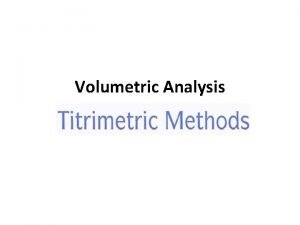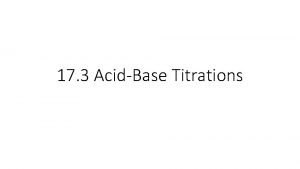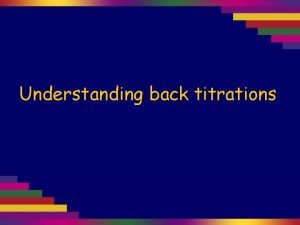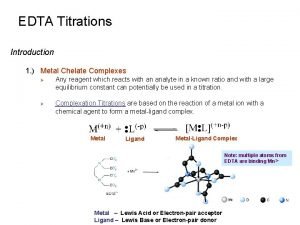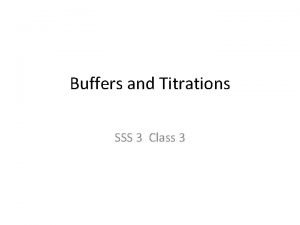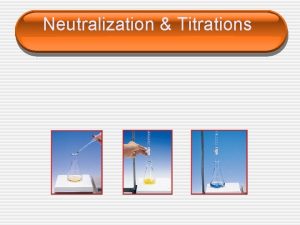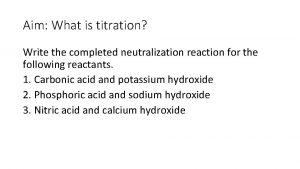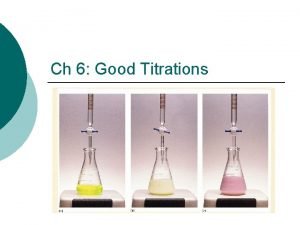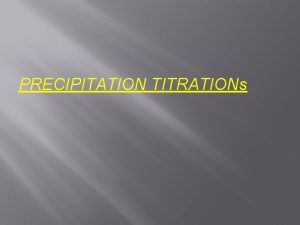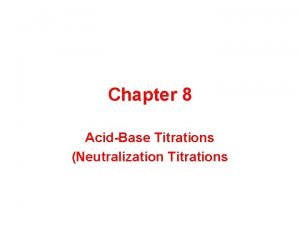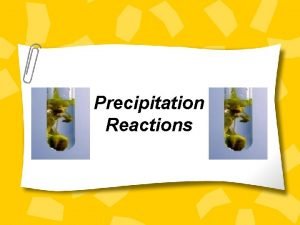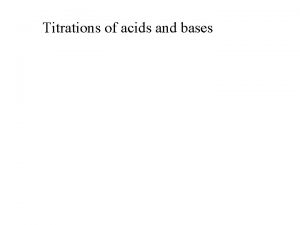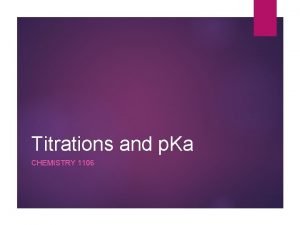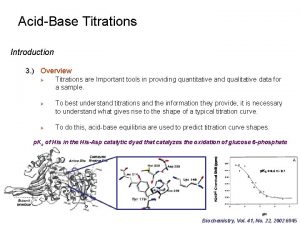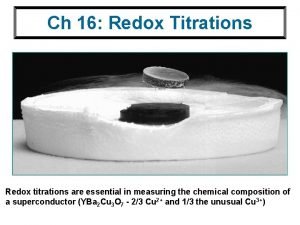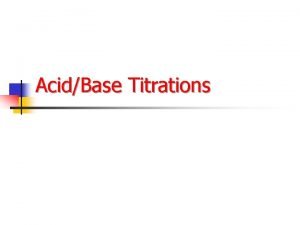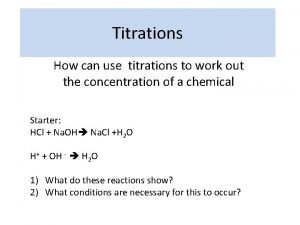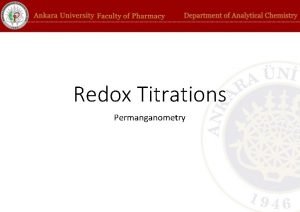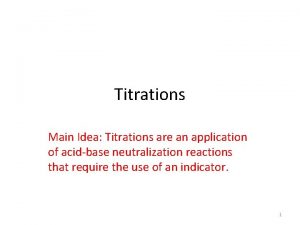Precipitation Titrations in which precipitates are formed are














- Slides: 14

Precipitation Titrations in which precipitates are formed are called precipitation titrations. The most frequent application of this type of titration uses silver ion to determine chloride. Therefore, these titrations are called argentometric titrations. According to the indicator used, three methods can be described. Chromate is the indicator in Mohr's method while Fajans method makes use of adsorption indicators. Both methods are direct methods. The third method is an indirect method where an excess silver is added to chloride unknown and the remaining silver is back-titrated with a standard thiocyanate solution in presence of Fe(III) as an indicator. 1

Titration Curves A titration curve for a precipitation titration can be constructed by plotting m. L Ag+ against p. X (X can be Cl-, Br-, I-, or SCN-) where the sharpness of the end point and the break is directly proportional to: 1. ksp of the silver salt. 2. The concentration of reactants. This is true when a suitable indicator concentration is used. Mixtures can also be titrated provided that enough difference in the solubilities of the two silver salts exists (at least 103). 2

Example Find the p. Cl in a 20 m. L of a 0. 10 M Cl- solution after addition of 0, 10, 20, and 30 m. L of 0. 10 M Ag. NO 3. Ksp = 1. 0 x 10 -10. Solution 1. After addition of 0 m. L Ag+ [Cl-] = 0. 10 M p. Cl = 1. 00 2. After addition of 10 m. L Ag+ Initial mmol Cl- = 0. 10 x 20 = 2. 0 Mmol Ag+ added = 0. 10 x 10 = 1. 0 Mmol Cl- excess = 2. 0 – 1. 0 = 1. 0 [Cl-]excess = 1. 0/30 = 0. 033 M 3

We should expect that this is the actual concentration present in solution since the solubility of Ag. Cl is very small (as seen from the ksp) and this is especially true since we have a common ion. However, let us try to calculate the [Cl-]dissociation of Ag. Cl. Ksp = s(1/30 + s), Assume 1/30 >> s 1. 0 x 10 -10 = 1/30 * s , s = 3 x 10 -9 M Therefore, [Cl-] = 0. 033 M, p. Cl = 1. 48 4

3. After addition of 20 m. L Ag+ Initial mmol Cl- = 0. 10 x 20 = 2. 0 Mmol Ag+ added = 0. 10 x 20 = 2. 0 Mmol Cl- excess = 2. 0 – 2. 0 = 0 This is the equivalence point Ksp = s * s S = (1. 0 x 10 -10)1/2 S = 1. 0 x 10 -5 M 5

4. After addition of 30 m. L Ag+ Initial mmol Cl- = 0. 10 x 20 = 2. 0 Mmol Ag+ added = 0. 10 x 30 = 3. 0 Mmol Ag+ excess =3. 0 – 2. 0 = 1. 0 [Ag+]excess = 1. 0/50 = 0. 02 M Therefore, once again we have a common ion situation. We should expect that this is the actual Ag+ concentration present in solution since the solubility of Ag. Cl is very small (as seen from the ksp) and this is especially true since we have a common ion. However, we can calculate the Cl- concentration from dissociation of Ag. Cl in presence of excess Ag+ since this is the only source of Cl -. 6

Ksp = (0. 02 + s) * s Assume that 0. 02 >> s 1. 0 x 10 -10 = 0. 02 S S = 5. 0 X 10 -9 M = [Cl-] p. Cl = 8. 30 7

Methods for Chloride Determination a. Mohr Method This method utilizes chromate as an indicator. Chromate forms a precipitate with Ag+ but this precipitate has a greater solubility than that of Ag. Cl, for example. Therefore, Ag. Cl is formed first and after all Cl- is consumed, the first drop of Ag+ in excess will react with the chromate indicator giving a reddish precipitate. 2 Ag+ + Cr. O 42 - (Yellow) = Ag 2 Cr. O 4 (Red) 8

In this method, neutral medium should be used since, in alkaline solutions, silver will react with the hydroxide ions forming Ag. OH. In acidic solutions, chromate will be converted to dichromate. Therefore, the p. H of solution should be kept at about 7. There is always some error in this method because a dilute chromate solution is used due to the intense color of the indicator. This will require additional amount of Ag+ for the Ag 2 Cr. O 4 to form. 9

Example Find the concentration of chloride in a 25 m. L solution to which few drops of K 2 Cr. O 4 were added, if the end point required 20 m. L of 0. 10 M Ag. NO 3. Solution Ag+ + Cl- D Ag. Cl(s) The reaction between silver ions and chloride is 1: 1 Mmol Ag+ = mmol Cl 0. 10 x 20 = MCl- * 25 MCl- = 0. 08 M 10

b. Volhard Method This is an indirect method for chloride determination where an excess amount of standard Ag+ is added to the chloride solution containing Fe 3+ as an indicator. The excess Ag+ is then titrated with standard SCN- solution untill a red color is obtained which results from the reaction: Fe 3+ (Yellow) + SCN- = Fe(SCN)2+ (Red) The indicator system is very sensitive and usually good results are obtained. The medium should be acidic to avoid the formation of Fe(OH)3. However, the use of acidic medium together with added SCN- titrant increase the solubility of the precipitate leading to significant errors. 11

This problem had been overcome by two main procedures: The first method includes addition of some nitrobenzene, which surrounds the precipitate and shields it from the aqueous medium. The second procedure involves filtration of the precipitate directly after precipitation, which protects the precipitate from coming in contact with the added SCN- solution 12

Example A 10 m. L of a chloride sample was treated with 15 m. L of 0. 1182 M Ag. NO 3. The excess silver was titrated with 0. 101 M SCN- requiring 2. 38 m. L to reach the red Fe(SCN)2+ end point. Find the concentration of chloride (At. Wt = 35. 5) in g/L. Solution mmol Ag+ reacted = mmol Ag+ taken - mmol Ag+ back-titrated mmol Ag+ reacted = mmol Clmmol. Ag+ back-titrated = mmol SCNmmol Cl- = 0. 1182 x 15 - 0. 101 x 2. 38 = 1. 53 MCl- = 1. 53/10 = 0. 153 M ? mg Cl- in 10 m. L = 1. 53 x 35. 5 = 54. 4 mg/L Cl- = 5. 44 x 103, g/L Cl- = 5. 44 g 13

C. Fajans Method Fluorescein and its derivatives are adsorbed to the surface of colloidal Ag. Cl. After all chloride is used, the first drop of Ag+ will react with fluorescein (Fl-) forming a reddish color. Ag+ + Fl- (Yellowish green) = Ag. Fl (Red) Since fluorescein and its derivatives are weak acids, the p. H of the solution should be slightly alkaline to keep the indicator in the anion form but, at the same time, is not alkaline enough to convert Ag+ into Ag. OH. Fluorescein derivatives that are stronger acids than fluorescien (like eosin) can be used at acidic p. H without problems. 14
 Precipitation titrations
Precipitation titrations Ludwig's
Ludwig's Keratic precipitates
Keratic precipitates Insidan region jh
Insidan region jh Steps of gravimetric analysis
Steps of gravimetric analysis Co precipitation and post precipitation
Co precipitation and post precipitation Complexometric titration definition
Complexometric titration definition Types of titrations
Types of titrations Titration vs back titration
Titration vs back titration Auxiliary complexing agent examples
Auxiliary complexing agent examples Buffers and titrations
Buffers and titrations Neutralization titrations
Neutralization titrations What is the titration formula
What is the titration formula Good titrations
Good titrations Regents
Regents






